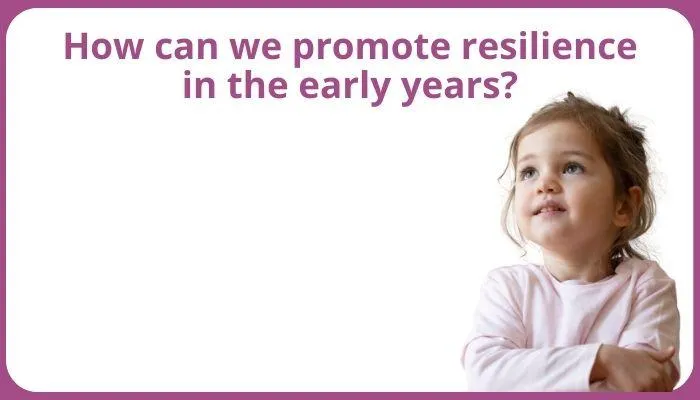Every child's well-being matters.
Well-being Articles

How can we promote resilience in the early years?
Resilience is the ability to bounce back from challenges, adapt to changes, and persevere through difficulties. In the early years, fostering resilience is a vital part of safeguarding and supporting children’s overall development and wellbeing. Building resilience equips children with the tools they need to face life's inevitable ups and downs while also promoting emotional regulation, self-confidence, and independence. Early years practitioners play a key role in embedding resilience into daily practice, helping children thrive in a safe and nurturing environment.
Why is resilience important in the early years?
Young children experience many transitions and challenges, such as starting nursery, making new friends, or navigating conflict during play. Resilience enables children to manage these experiences positively, reducing stress and anxiety while fostering a sense of control and security. Research shows that children who develop resilience in the early years are better equipped to cope with adversity later in life, contributing to their long-term mental health and emotional wellbeing.
Promoting resilience also aligns with safeguarding practices. When children feel supported, valued, and listened to, they are more likely to communicate their feelings and seek help if needed. This openness is a critical factor in protecting children from harm and ensuring they feel safe in their environment.
Practical strategies to build resilience
Building resilience in young children requires a holistic approach that encompasses relationships, routines, and the learning environment. Early years settings can foster resilience through the following strategies:
Develop strong relationships: Positive relationships with trusted adults are the foundation of resilience. Practitioners can build these connections by being warm, responsive, and consistent in their interactions with children. Taking time to listen and validate children's feelings also creates a secure base for them to explore and grow.
Encourage problem-solving: Allow children to face manageable challenges during play or learning activities. Guide them in finding solutions by asking open-ended questions, providing encouragement, and praising their efforts rather than focusing solely on outcomes.
Model resilience: Practitioners can model resilient behaviour by demonstrating how to handle stress, adapt to change, and resolve conflicts calmly. This gives children practical examples of coping strategies they can emulate.
Create a safe and predictable environment: Consistent routines and clear boundaries help children feel secure and reduce anxiety. A safe and predictable environment also encourages risk-taking in play, which is essential for building confidence and problem-solving skills.
Teach emotional regulation: Help children recognise and name their emotions, and provide tools such as breathing exercises or calming activities to manage feelings like frustration or sadness. This supports their ability to cope with challenges constructively.
Celebrate effort and persistence: Acknowledge children's perseverance and effort, even when tasks are difficult. This reinforces a growth mindset and helps children view setbacks as opportunities to learn and improve.
The role of families and communities
Resilience-building extends beyond the early years setting and requires collaboration with families. Practitioners can support parents by sharing strategies, offering resources, and encouraging open communication about their child’s development. Community involvement, such as accessing local playgroups or support networks, also plays a vital role in fostering resilience by giving children opportunities to interact with a diverse range of people and experiences.
Promoting resilience in young children is a cornerstone of safeguarding and wellbeing. By creating nurturing environments, modelling positive behaviours, and teaching practical coping skills, early years practitioners empower children to navigate challenges with confidence and optimism. These early foundations of resilience not only protect children in their formative years but also prepare them for a lifetime of growth and adaptability.
AUTHOR:- Iona has nearly 10 years of experience supporting nurseries and childminders in curriculum planning, leadership, and safeguarding. Her writing is informed by public information and sector insight, aiming to provide accessible, practical support for professionals working with children. She is part of the On the Button team, helping deliver Well-being, Safeguarding and Complaint Management Software that empowers practitioners to identify concerns early and act confidently.
On the Button provides innovative software tailored to the needs of the early years sector, with a strong focus on EYFS well-being and early years safeguarding. Our tools help senior practitioners to confidently track concerns, maintain robust records, and respond effectively — all while meeting statutory guidance. From early years complaint management to team-wide safeguarding alerts, our platform puts children's safety and emotional health first.


How can we promote resilience in the early years?
Resilience is the ability to bounce back from challenges, adapt to changes, and persevere through difficulties. In the early years, fostering resilience is a vital part of safeguarding and supporting children’s overall development and wellbeing. Building resilience equips children with the tools they need to face life's inevitable ups and downs while also promoting emotional regulation, self-confidence, and independence. Early years practitioners play a key role in embedding resilience into daily practice, helping children thrive in a safe and nurturing environment.
Why is resilience important in the early years?
Young children experience many transitions and challenges, such as starting nursery, making new friends, or navigating conflict during play. Resilience enables children to manage these experiences positively, reducing stress and anxiety while fostering a sense of control and security. Research shows that children who develop resilience in the early years are better equipped to cope with adversity later in life, contributing to their long-term mental health and emotional wellbeing.
Promoting resilience also aligns with safeguarding practices. When children feel supported, valued, and listened to, they are more likely to communicate their feelings and seek help if needed. This openness is a critical factor in protecting children from harm and ensuring they feel safe in their environment.
Practical strategies to build resilience
Building resilience in young children requires a holistic approach that encompasses relationships, routines, and the learning environment. Early years settings can foster resilience through the following strategies:
Develop strong relationships: Positive relationships with trusted adults are the foundation of resilience. Practitioners can build these connections by being warm, responsive, and consistent in their interactions with children. Taking time to listen and validate children's feelings also creates a secure base for them to explore and grow.
Encourage problem-solving: Allow children to face manageable challenges during play or learning activities. Guide them in finding solutions by asking open-ended questions, providing encouragement, and praising their efforts rather than focusing solely on outcomes.
Model resilience: Practitioners can model resilient behaviour by demonstrating how to handle stress, adapt to change, and resolve conflicts calmly. This gives children practical examples of coping strategies they can emulate.
Create a safe and predictable environment: Consistent routines and clear boundaries help children feel secure and reduce anxiety. A safe and predictable environment also encourages risk-taking in play, which is essential for building confidence and problem-solving skills.
Teach emotional regulation: Help children recognise and name their emotions, and provide tools such as breathing exercises or calming activities to manage feelings like frustration or sadness. This supports their ability to cope with challenges constructively.
Celebrate effort and persistence: Acknowledge children's perseverance and effort, even when tasks are difficult. This reinforces a growth mindset and helps children view setbacks as opportunities to learn and improve.
The role of families and communities
Resilience-building extends beyond the early years setting and requires collaboration with families. Practitioners can support parents by sharing strategies, offering resources, and encouraging open communication about their child’s development. Community involvement, such as accessing local playgroups or support networks, also plays a vital role in fostering resilience by giving children opportunities to interact with a diverse range of people and experiences.
Promoting resilience in young children is a cornerstone of safeguarding and wellbeing. By creating nurturing environments, modelling positive behaviours, and teaching practical coping skills, early years practitioners empower children to navigate challenges with confidence and optimism. These early foundations of resilience not only protect children in their formative years but also prepare them for a lifetime of growth and adaptability.
AUTHOR:- Iona has nearly 10 years of experience supporting nurseries and childminders in curriculum planning, leadership, and safeguarding. Her writing is informed by public information and sector insight, aiming to provide accessible, practical support for professionals working with children. She is part of the On the Button team, helping deliver Well-being, Safeguarding and Complaint Management Software that empowers practitioners to identify concerns early and act confidently.
On the Button provides innovative software tailored to the needs of the early years sector, with a strong focus on EYFS well-being and early years safeguarding. Our tools help senior practitioners to confidently track concerns, maintain robust records, and respond effectively — all while meeting statutory guidance. From early years complaint management to team-wide safeguarding alerts, our platform puts children's safety and emotional health first.


How can we promote resilience in the early years?
Resilience is the ability to bounce back from challenges, adapt to changes, and persevere through difficulties. In the early years, fostering resilience is a vital part of safeguarding and supporting children’s overall development and wellbeing. Building resilience equips children with the tools they need to face life's inevitable ups and downs while also promoting emotional regulation, self-confidence, and independence. Early years practitioners play a key role in embedding resilience into daily practice, helping children thrive in a safe and nurturing environment.
Why is resilience important in the early years?
Young children experience many transitions and challenges, such as starting nursery, making new friends, or navigating conflict during play. Resilience enables children to manage these experiences positively, reducing stress and anxiety while fostering a sense of control and security. Research shows that children who develop resilience in the early years are better equipped to cope with adversity later in life, contributing to their long-term mental health and emotional wellbeing.
Promoting resilience also aligns with safeguarding practices. When children feel supported, valued, and listened to, they are more likely to communicate their feelings and seek help if needed. This openness is a critical factor in protecting children from harm and ensuring they feel safe in their environment.
Practical strategies to build resilience
Building resilience in young children requires a holistic approach that encompasses relationships, routines, and the learning environment. Early years settings can foster resilience through the following strategies:
Develop strong relationships: Positive relationships with trusted adults are the foundation of resilience. Practitioners can build these connections by being warm, responsive, and consistent in their interactions with children. Taking time to listen and validate children's feelings also creates a secure base for them to explore and grow.
Encourage problem-solving: Allow children to face manageable challenges during play or learning activities. Guide them in finding solutions by asking open-ended questions, providing encouragement, and praising their efforts rather than focusing solely on outcomes.
Model resilience: Practitioners can model resilient behaviour by demonstrating how to handle stress, adapt to change, and resolve conflicts calmly. This gives children practical examples of coping strategies they can emulate.
Create a safe and predictable environment: Consistent routines and clear boundaries help children feel secure and reduce anxiety. A safe and predictable environment also encourages risk-taking in play, which is essential for building confidence and problem-solving skills.
Teach emotional regulation: Help children recognise and name their emotions, and provide tools such as breathing exercises or calming activities to manage feelings like frustration or sadness. This supports their ability to cope with challenges constructively.
Celebrate effort and persistence: Acknowledge children's perseverance and effort, even when tasks are difficult. This reinforces a growth mindset and helps children view setbacks as opportunities to learn and improve.
The role of families and communities
Resilience-building extends beyond the early years setting and requires collaboration with families. Practitioners can support parents by sharing strategies, offering resources, and encouraging open communication about their child’s development. Community involvement, such as accessing local playgroups or support networks, also plays a vital role in fostering resilience by giving children opportunities to interact with a diverse range of people and experiences.
Promoting resilience in young children is a cornerstone of safeguarding and wellbeing. By creating nurturing environments, modelling positive behaviours, and teaching practical coping skills, early years practitioners empower children to navigate challenges with confidence and optimism. These early foundations of resilience not only protect children in their formative years but also prepare them for a lifetime of growth and adaptability.
AUTHOR:- Iona has nearly 10 years of experience supporting nurseries and childminders in curriculum planning, leadership, and safeguarding. Her writing is informed by public information and sector insight, aiming to provide accessible, practical support for professionals working with children. She is part of the On the Button team, helping deliver Well-being, Safeguarding and Complaint Management Software that empowers practitioners to identify concerns early and act confidently.
On the Button provides innovative software tailored to the needs of the early years sector, with a strong focus on EYFS well-being and early years safeguarding. Our tools help senior practitioners to confidently track concerns, maintain robust records, and respond effectively — all while meeting statutory guidance. From early years complaint management to team-wide safeguarding alerts, our platform puts children's safety and emotional health first.


How can we promote resilience in the early years?
Resilience is the ability to bounce back from challenges, adapt to changes, and persevere through difficulties. In the early years, fostering resilience is a vital part of safeguarding and supporting children’s overall development and wellbeing. Building resilience equips children with the tools they need to face life's inevitable ups and downs while also promoting emotional regulation, self-confidence, and independence. Early years practitioners play a key role in embedding resilience into daily practice, helping children thrive in a safe and nurturing environment.
Why is resilience important in the early years?
Young children experience many transitions and challenges, such as starting nursery, making new friends, or navigating conflict during play. Resilience enables children to manage these experiences positively, reducing stress and anxiety while fostering a sense of control and security. Research shows that children who develop resilience in the early years are better equipped to cope with adversity later in life, contributing to their long-term mental health and emotional wellbeing.
Promoting resilience also aligns with safeguarding practices. When children feel supported, valued, and listened to, they are more likely to communicate their feelings and seek help if needed. This openness is a critical factor in protecting children from harm and ensuring they feel safe in their environment.
Practical strategies to build resilience
Building resilience in young children requires a holistic approach that encompasses relationships, routines, and the learning environment. Early years settings can foster resilience through the following strategies:
Develop strong relationships: Positive relationships with trusted adults are the foundation of resilience. Practitioners can build these connections by being warm, responsive, and consistent in their interactions with children. Taking time to listen and validate children's feelings also creates a secure base for them to explore and grow.
Encourage problem-solving: Allow children to face manageable challenges during play or learning activities. Guide them in finding solutions by asking open-ended questions, providing encouragement, and praising their efforts rather than focusing solely on outcomes.
Model resilience: Practitioners can model resilient behaviour by demonstrating how to handle stress, adapt to change, and resolve conflicts calmly. This gives children practical examples of coping strategies they can emulate.
Create a safe and predictable environment: Consistent routines and clear boundaries help children feel secure and reduce anxiety. A safe and predictable environment also encourages risk-taking in play, which is essential for building confidence and problem-solving skills.
Teach emotional regulation: Help children recognise and name their emotions, and provide tools such as breathing exercises or calming activities to manage feelings like frustration or sadness. This supports their ability to cope with challenges constructively.
Celebrate effort and persistence: Acknowledge children's perseverance and effort, even when tasks are difficult. This reinforces a growth mindset and helps children view setbacks as opportunities to learn and improve.
The role of families and communities
Resilience-building extends beyond the early years setting and requires collaboration with families. Practitioners can support parents by sharing strategies, offering resources, and encouraging open communication about their child’s development. Community involvement, such as accessing local playgroups or support networks, also plays a vital role in fostering resilience by giving children opportunities to interact with a diverse range of people and experiences.
Promoting resilience in young children is a cornerstone of safeguarding and wellbeing. By creating nurturing environments, modelling positive behaviours, and teaching practical coping skills, early years practitioners empower children to navigate challenges with confidence and optimism. These early foundations of resilience not only protect children in their formative years but also prepare them for a lifetime of growth and adaptability.
AUTHOR:- Iona has nearly 10 years of experience supporting nurseries and childminders in curriculum planning, leadership, and safeguarding. Her writing is informed by public information and sector insight, aiming to provide accessible, practical support for professionals working with children. She is part of the On the Button team, helping deliver Well-being, Safeguarding and Complaint Management Software that empowers practitioners to identify concerns early and act confidently.
On the Button provides innovative software tailored to the needs of the early years sector, with a strong focus on EYFS well-being and early years safeguarding. Our tools help senior practitioners to confidently track concerns, maintain robust records, and respond effectively — all while meeting statutory guidance. From early years complaint management to team-wide safeguarding alerts, our platform puts children's safety and emotional health first.





Facebook
Instagram
LinkedIn
Youtube